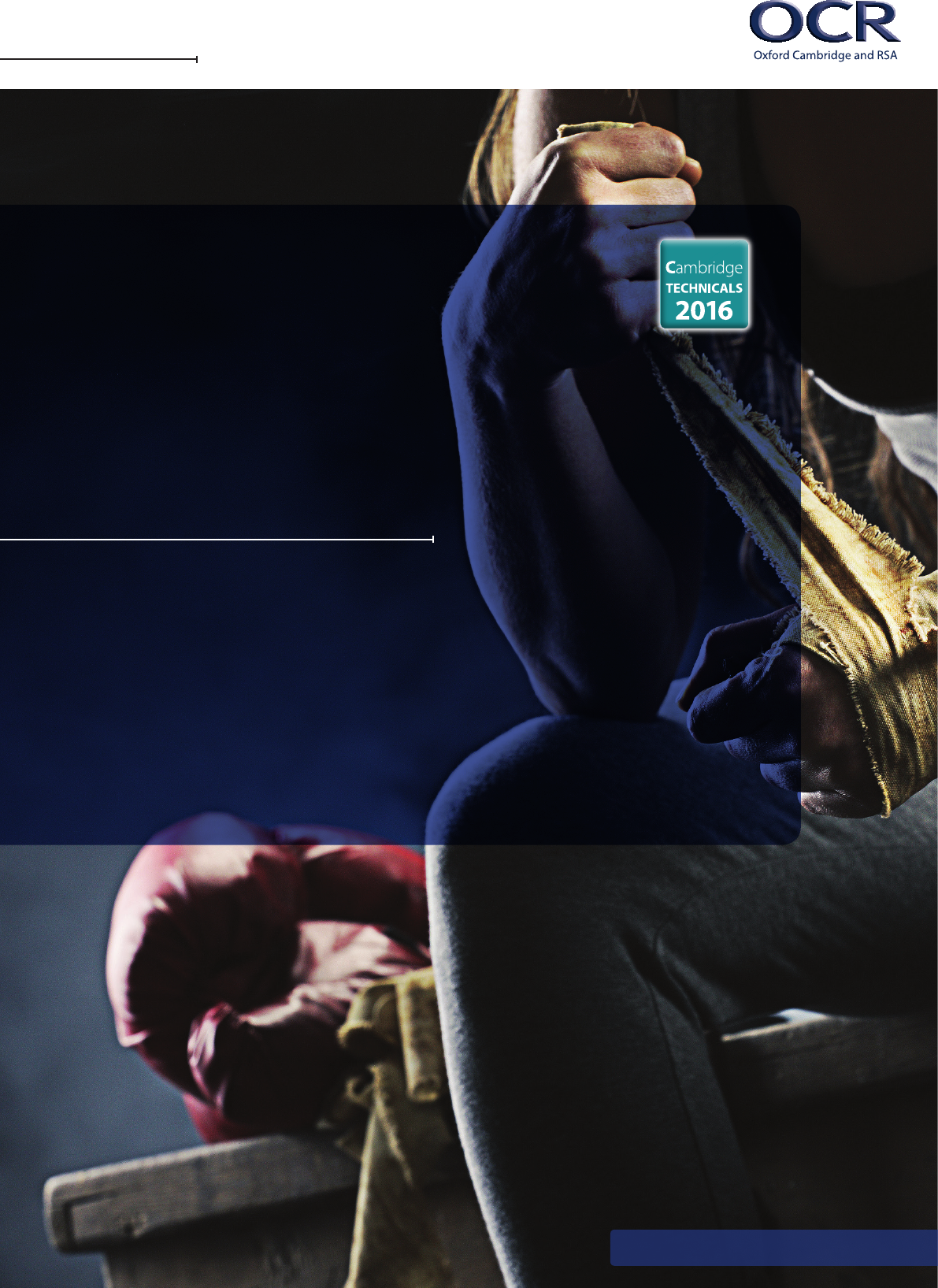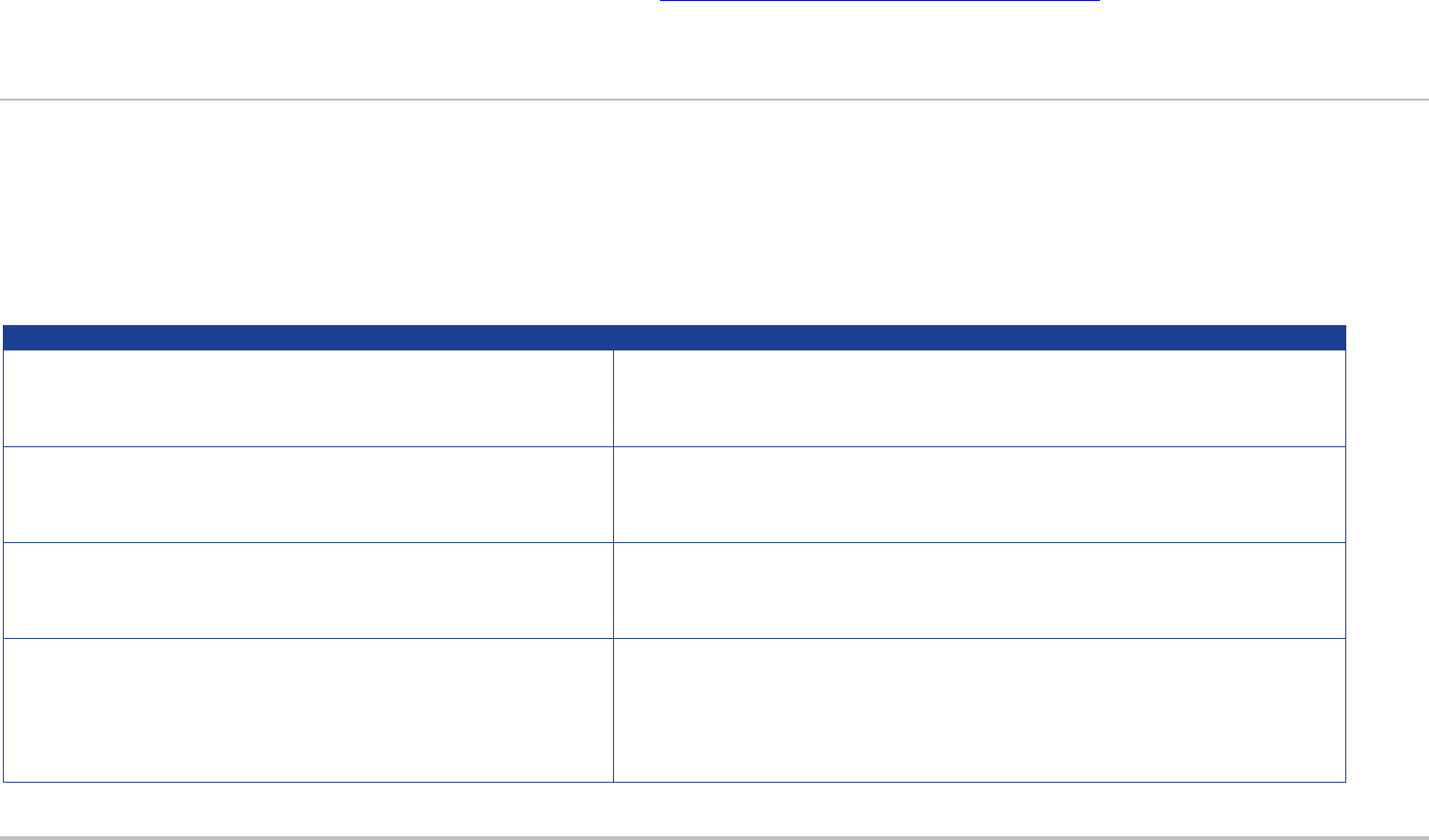
ocr.org.uk/sport
Unit 1
9
Sport and exercise psychology
M/507/4470
Guided learning hours: 60
Version 4 - revised August 2022
*changes indicated by black line
Cambridge TECHNICALS LEVEL 3
2016 Suite
SPORT AND
PHYSICAL
ACTIVITY

First teaching September 2016
© OCR 2022 (Version 4: August 2022) 1 Unit 19: Sport and exercise psychology
LEVEL 3
UNIT 19: Sport and exercise psychology
M/507/4470
Guided learning hours: 60
Essential resources required for this unit:
none
T
his unit is internally assessed and externally moderated by OCR.
UNIT AIM
Not only do participants in sport and exercise need to train their bodies but it is becoming
increasingly important that they also train their minds. Failing to attend a coaching session
through a lack of motivation, a fall out with a teammate or an overly aggressive response
to a bad challenge could mean the difference between winning and losing. Equally as
important, participation in sport and exercise is proven to have positive impacts on mental
health and wellbeing and can help improve a person’s overall quality of life.
In this unit you will learn different motivations that people have for participating in sport and
exercise and how performance can be managed through an understanding of attribution
theory, stress and group dynamics. You will also learn the impacts that participation in
sport and exercise can have on a person’s mental health and wellbeing, whether an elite
performer or a member of the general public.

First teaching September 2016
© OCR 2022 (Version 4: August 2022) 2 Unit 19: Sport and exercise psychology
TEACHING CONTENT
The teaching content in every unit states what has to be taught to ensure that learners are able to
access the highest grades.
Anything which follows an i.e. details what must be taught as part of that area of content. Anything
which follows an e.g. is illustrative; it should be noted that where e.g. is used, learners must know
and be able to apply relevant examples in their work, although these do not need to be the same
ones specified in the unit content.
For
internally assessed units you need to ensure that any assignments you create, or any
modifications you make to an assignment, do not expect the learner to do more than they have
been taught, but must enable them to access the full range of grades as described in the grading
criteria.
Learning outcomes
Teaching content
The Learner will:
Learners must be taught:
1. Know the different
factors that affec
t
m
otivation for sport
and exercise
1.1 Types of motivation, i.e.
• intrinsic
• extrinsic
• achievement motivation theory
1.
2 Goal setting, i.e.
• short, medium and long-term goals
• SMARTER principle of goal setting
1.
3 Differences in motivation between general participation compared
to elite performers (e.g. intrinsic or extrinsic, high levels of
motivation at elite level, team of people to motivate elite level, self-
motivation relevant to both participation and elite, elite perhaps
more goal orientated in their motivation)
1.4 Differences in goals between general participation compared to
elite performers (e.g. increased confidence, weight loss, making
friends, increased tone, getting fitter compared to winning medals,
breaking records, representing country, to be the best, rankings)
2. Understand
attribution theory in
relation to sport
and exercise
2.1 Weiner’s model of attribution, i.e.
• locus of causality
• stability
• how individuals could attribute success or failure, i.e
.
o internal stable (e.g. ability)
o internal unstable (e.g. effort)
o external stable (e.g. task difficulty)
o external unstable (e.g. luck)
2.
2 The effect of different attributions on sport and exercise
performance (e.g. which type of attribution should made be made
for success or failure (e.g. attribute failure to external factors and
success to internal factors to maintain confidence), attribution
bias, mastery orientation, learned helplessness)

First teaching September 2016
© OCR 2022 (Version 4: August 2022) 3 Unit 19: Sport and exercise psychology
Learning outcomes
Teaching content
The Learner will:
Learners must be taught:
2.3 Attribution retraining, i.e.
• how a coach/personal trainer could help the individual change
their perception of the causes of failure (e.g. poor ability vs
lack of effort as cause of failure)
• effects of attribution retraining (e.g. increase confidence,
encourage mastery orientation, maintain participation)
3. Understand the
effects of stress
,
anx
iety
and
ar
ousal in sport
and exercise
3.1 Stress, i.e.
• definition
• types, i.e.
o eustress
o distress
• causes
• symptoms
• effects on both sporting and general exercise performance
3.
2 Anxiety, i.e.
• definition
• types, i.e
.
o t
rai
t
o s
tate
• causes
• symptoms
• effects on both sporting and general exercise performance
3.
3 Arousal, i.e.
• definition
• theories of arousal (e.g. drive theory, inverted U hypothesis,
catastrophe theory, reversal theory, IZOF)
• effects on both sporting and general exercise performance
3.
4 Methods of controlling stress, anxiety and arousal (e.g. self-talk,
imagery, mental rehearsal, positive thinking, confidence building,
concentration, progressive muscular relaxation, goal setting, cue
utilisation, thought stopping)

First teaching September 2016
© OCR 2022 (Version 4: August 2022) 4 Unit 19: Sport and exercise psychology
Learning outcomes
Teaching content
The Learner will:
Learners must be taught:
4. Understand the
importance of
group dynamics in
team sports
and
g
roup exercise
4.1 Stages of group development, i.e.
• forming, storming, norming and performing of both a sports
team and a group activity (e.g. running group, aerobics class)
4.
2 Cohesion, i.e.
• types, i.e.
o task
o social
• creating an effective team climate
• factors affecting cohesion (e.g. personal, environmental,
goals, leadership)
• of both a sports team and a group activity (e.g. running group,
aerobics class, outdoor adventure activity)
4.
3 Steiner’s model of group effectiveness, i.e.
• motivational losses
• coordination losses
4.4 Methods for improving team cohesion (task and social) (e.g. give
individual roles, team building exercises, create a group identity
5. Understand the
psychological
impact of sport and
exercise on mental
healt
h and
w
ellbeing
5.1 Impact of sport and exercise on mental health (e.g.
depression, psychosomatic illnesses) and wellbeing (e.g. work-life
balance, social relationships)
5.
2 Use of exercise to treat certain psychosomatic illnesses (e.g.
depression, high blood pressure, stress, anxiety, eczema)
5.
3 Different psychological impacts of sport and exercise for elite
performers and general participants (e.g. elite level athletes not
making the grade or feeling the pressure, retiring athletes, serious
injury, non-sport related issues)

First teaching September 2016
© OCR 2022 (Version 4: August 2022) 5 Unit 19: Sport and exercise psychology
GRADING CRITERIA
LO
Pass
Merit
Distinction
The assessment criteria are the Pass
requirements for this unit.
To achieve a Merit the evidence must
show that, in addition to the Pass
criteria, the candidate is able to:
To achieve a Distinction the evidence
must show that, in addition to the pass
and merit criteria, the candidate is
able to:
1. Know the different factors
that affect motivation for
sport and exercise
P1*: Describe types of motivation and
goal setting, and how they can
improve performance in sport and
exercise
M1: Explain how motivation may differ
at different levels of performance in
sport and exercise
2. Understand attribution
theory in relation to sport
and exercise
P2: Describe attribution theory in
relation to sport and exercise
M2: Describe the possible ways an
individual could attribute their
successes or failures
D1: Explain how attribution retraining
could help improve an individual’s
performance in sport and exercise
3. Understand the effects of
stress, anxiety and arousal
in sport and exercise
*P3: Explain stress and anxiety, their
causes, symptoms and effect on sport
and exercise performance
M3: Explain the methods that could be
used to control stress, anxiety and
arousal in sport for different levels of
performer
*P4: Explain the effects of arousal on
sport and exercise performance using
relevant theories
4. Understand the
importance of gr
oup
dy
namics in team sports
and group exercise
P5*: Explain the process of how a
group forms with reference to factors
affecting cohesion
M4: Explain the motivational and
coordination losses that an exercise
group or sports team may experience
D2: Evaluate methods a coach could
use to improve task and social
cohesion of a specific exercise group
or sports team
5. Understand the
psychological impact of
sport and exercise on
mental health and
wellbeing
*P6: Explain the impact of sport and
exercise on mental health and
w
ellbeing
M5: Analyse how the psychological
impacts of sport and exercise might
be different for elite performers and
general participants
P7: Explain how sport and exercise
could be used to treat a specific
medical condition

First teaching September 2016
© OCR 2022 (Version 4: August 2022) 6 Unit 19: Sport and exercise psychology
SYNOPTIC LEARNING AND ASSESSMENT
It will be possible for learners to make connections between other units over and above the unit containing the key tasks for synoptic assessment, please
see section 6 of the centre handbook for more details. We have indicated in this unit where these links are with an asterisk and provided more detail in the
assessment guidance section below.
ASSESSMENT GUIDANCE
LO1 Know the different factors that affect motivation for sport and exercise
Learners must use specific sport and/or exercise examples. Learners must describe each of the types of motivation and goal setting types outlined in the
Teaching Content. For M1, learners must explain the differences in motivation between elite performer and general participants in at least two different forms
of sport and/or exercise. For this LO, learners will benefit from drawing on learning from mandatory Unit 2, Sports coaching and activity leadership – LO4 Be
able to plan sports and activity sessions. Learners may also draw on learning from Unit 7, Improving fitness for sport and physical activity and Unit 11, Physical
activity for specific groups.
LO2: Understand attribution theory in relation to sport and exercise
Learners must use specific sport and/or exercise examples (including M2 and D1).
LO
3: Understand the effects of stress, anxiety and arousal in sport and exercise
Learners must use specific sport and/or exercise examples (including M3). For this LO, learners may draw on learning from Unit 17, Sports injuries and
rehabilitation.
LO4 Understand the importance of group dynamics in team sports and group exercise
Learners must use specific sport and/or exercise examples. For M4 and D2, learners must be able to explain what happens when teams are unable to work
together effectively and the actions a coach may take to remedy this and how effective they might be. Ideally this would be supported by specific sporting
examples. For this LO, learners will benefit from drawing on learning from mandatory Unit 2, Sports coaching and activity leadership – LO2 Understand
principles which underpin coaching and leading. Learners may also benefit from drawing on learning from Unit 18, Practical skills in sport and physical activity.
LO
5 Understand the psychological impact of sport and exercise on mental health and wellbeing
Learners should consider the psychological impacts of sport and exercise to the health and wellbeing of general participants. For P7, the medical condition
must be psychosomatic and the psychological treatment through sport and exercise considered. For M5, learners should then analyse differences in
psychological impacts of sport and exercise between general participants and elite athletes. For this LO, learners may benefit from drawing on learning from
Unit 7, Improving fitness for sport and physical activity; Unit 11, Physical activity for specific groups and Unit 12, Nutrition and diet for sport and exercise.
Feedback to learners: you can discuss work-in-progress towards summative assessment with learners to make sure it’s being done in a planned and
timely manner. It also provides an opportunity for you to check the authenticity of the work. You must intervene if you feel there’s a health and safety risk.
Learners should use their own words when producing evidence of their knowledge and understanding. When learners use their own words it reduces the
possibility of learners’ work being identified as plagiarised. If a learner does use someone else’s words and ideas in their work, they must acknowledge it,

First teaching September 2016
© OCR 2022 (Version 4: August 2022) 7 Unit 19: Sport and exercise psychology
and this is done through referencing. Just quoting and referencing someone else’s work will not show that the learner knows or understands it. It has to be
clear in the work how the learner is using the material they have referenced to inform their thoughts, ideas or conclusions.
For more information about internal assessment, including feedback, authentication and plagiarism, see the centre handbook. Information about how to
reference is in the OCR Guide to Referencing available on our website:
http://www.ocr.org.uk/i-want-to/skills-guides/.
MEANINGFUL EMPLOYER INVOLVEMENT - a requirement for the Foundation Diploma and Diploma (Tech Level)
qualifications
The ‘Diploma’ qualifications have been designed to be recognised as Tech Levels in performance tables in England. It is a requirement of these
qualifications for centres to secure employer involvement through delivery and/or assessment of these qualifications for every learner.
T
he minimum amount of employer involvement must relate to at least one or more of the elements of mandatory content.
E
ligible activities and suggestions/ideas that may help you in securing meaningful employer involvement for this unit are given in the table below.
Please refer to the Qualification Handbook for further information including a list of activities that are not considered to meet this requirement.
Meaningful employer involvement
Suggestion/ideas for centres when delivering this unit
1. Learners undertake structured work experience or work
placements that develop skills and knowledge relevant to
t
he qualification.
Learners could shadow the coach of a sports team to witness methods of
improving task and social cohesion.
2. Learners undertake project(s), exercises(s) and/or
assessments/examination(s) set with input from industry
practitioner(s).
Sports psychologists, counsellors, doctors or coaches could provide case
studies to centres which learners can then base their assessment evidence
on.
3. Learners take one or more units delivered or co-delivered by
an industry practitioner(s). This could take the form of
master classes or guest lectures.
Sports psychologists, counsellors, doctors or coaches could deliver guest
lectures to learners about the impacts of psychology on sport and/or the
impacts of sport and exercise on mental health and wellbeing as well as team
cohesion and group dynamics.
4. Industry practitioners operating as ‘expert witnesses’ that
contribute to the assessment of a learner’s work or practice,
operating within a specified assessment framework. This
may be a specific project(s), exercise(s) or examination(s),
or all assessments for a qualification.
Sports psychologists, counsellors, doctors or coaches could contribute to the
assessment of learners’ work.

For more information visit
ocr.org.uk
facebook.com/ocrexams
twitter.com/ocrexams
instagram.com/ocrexaminations
linkedin.com/company/ocr
youtube.com/ocrexams
Call our customer support centre on
01223 553998
Alternatively, you can email us on
support@ocr.org.uk
Visit our online support centre at
support.ocr.org.uk
OCR is part of Cambridge University Press & Assessment, a department of the University of Cambridge.
For sta training purposes and as part of our quality assurance programme your call may be recorded or monitored. ©OCR 2022 Oxford Cambridge and
RSAExaminations is a Company Limited by Guarantee. Registered in England. Registered oce The Triangle Building, Shaftesbury Road, Cambridge, CB2 8EA.
Registered company number 3484466. OCR is an exempt charity.
OCR operates academic and vocational qualications regulated by Ofqual, Qualications Wales and CCEA as listed in their qualications registers including
ALevels, GCSEs, Cambridge Technicals and Cambridge Nationals.
Cambridge University Press & Assessment is committed to making our documents accessible in accordance with the WCAG 2.1 Standard. We’re always looking
to improve the accessibility of our documents. If you nd any problems or you think we’re not meeting accessibility requirements, please contact us.
